Sheet packages
 |
|
| Box container compactly packed with sheet packages |
It is ideal if the sheet packages to be packed are tailored to container dimensions as transport modules in such a manner that compact packing is possible.
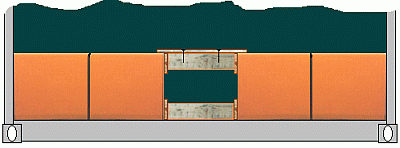 |
|
| "Aisle" braced with boards and squared lumber |
Since this not usually the case, the packages should be packed flush against the container side walls and the "aisle" remaining in the middle should be braced with squared lumber and boards.
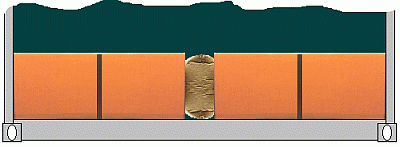 |
|
| "Aisle" filled with airbags |
If the aisle is around 20 cm wide, airbags can certainly be considered for filling the gap. It must, however, be ensured that jolting in transit cannot cause the airbags to shift upwards.
Stainless steel sheet in unitized wooden cases
Carefully thought out stowage patterns are a fundamental prerequisite for reasonable load securing and help to minimize labor and material costs. Good stowage planning also ensures that subsequently discovered securing shortcomings can be corrected more quickly and cheaply.
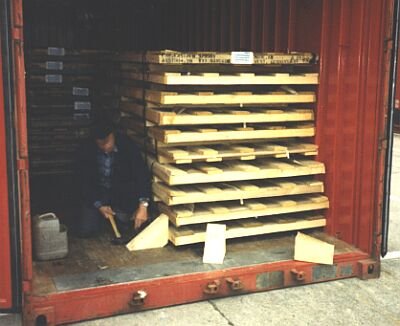 |
|
| Unfavorable stowage pattern and inadequate securing |
In this case, stainless steel sheet in wooden cases is being stowed, groups of ten cases being unitized with steel strapping to form a cargo unit. Neither the stowage plan nor the securing is adequate. Since each unit has a mass of approx. 4 metric tons, securing with wedges is not possible and is thus completely inappropriate.
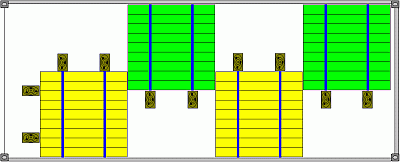 |
|
| Stowage pattern and inadequate securing - plan view |
The plan view shows the overall packing method. Each cargo unit is "secured" laterally with 2 incorrectly cut wedges, each of which is fastened to the container floor with one tension nail and two retaining nails. Assuming normal shear strengths, the units are "secured" with a force of approx. 400 daN, instead of the necessary 3,200 daN.
No action has been taken to counter the tipping forces which occur in maritime transport. All four units, with a total mass of approx. 16 metric tons, are also "secured" in the lengthwise direction with only two wedges which may likewise be expected to provide a securing force of only approx. 400 daN, instead of the 6,400 daN required to withstand the acceleration forces anticipated in maritime transport and the 12,800 daN in road transport.
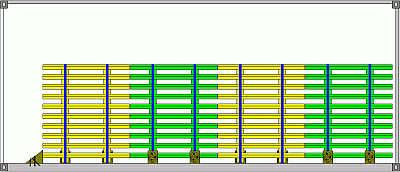 |
|
| Stowage pattern and inadequate securing - side view |
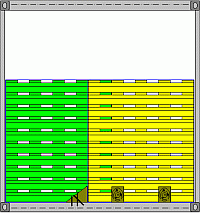 |
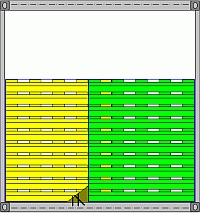 |
|
| View from the door | View from the front end |
Due to inadequate stowage planning, it is difficult to remedy the securing deficiencies. Since the final unit is in the door area, sensible securing methods cannot be used. The result, as in the following similar case, is an unsatisfactory improvised stop gap.
 |
 |
|
| Improvised securing against a corner post and the left-hand door leaf |
||
Just using a different packing method could have created ideal conditions for reasonable securing.
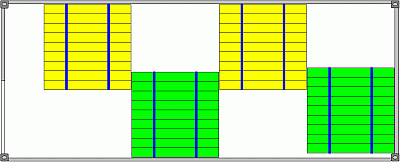 |
|
| Advantageous packing method facilitates subsequent securing. |
This packing method would mean that the final cargo unit would be located in the vicinity of the left-hand door leaf, so allowing it to be closed and act as an abutment for horizontally placed bracing.
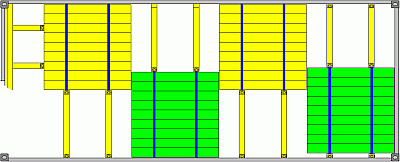 |
|
| Securing by horizontal bracing with wooden beams |
Once packed, each package is braced against the container walls. The final cargo unit is additionally braced against the left-hand door leaf.
In detail, the securing arrangements could look as follows:
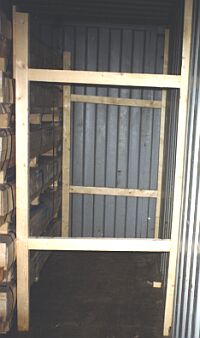 |
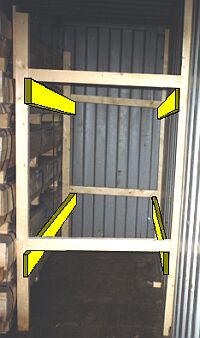 |
|
| Lateral securing with vertical uprights and transverse squared lumber beams | Securing as before, but joined together with boards |
Sufficient lateral securing can be provided by inserting 6 cm x 8 cm wooden bracing members. The left-hand variant may be considered adequate if
- the upright members are firmly located between the container corrugations,
- the upright members can be nailed into place on the cargo and
- the horizontal wooden bracing members can be securely fasted onto the upright members.
If the bracing is not durably fixed in place as in the left-hand Figure, additional lengthwise board connectors should be provided as in the right-hand Figure.
Various methods are feasible for final securing in the door area:
 |
|
| Horizontal bracing in the door area - side view and plan view |
Bracing applied horizontally against the door leaf is only advisable if the residual forces to be absorbed are not excessively large. This will be the case if friction-enhancing material has been laid beneath the cargo units so that relatively high friction forces already apply.
 |
If there is a risk that transferring the forces to the door leaf could result in overloading, one solution is to use "shoring", which transfers the forces into the door header and the container floor.